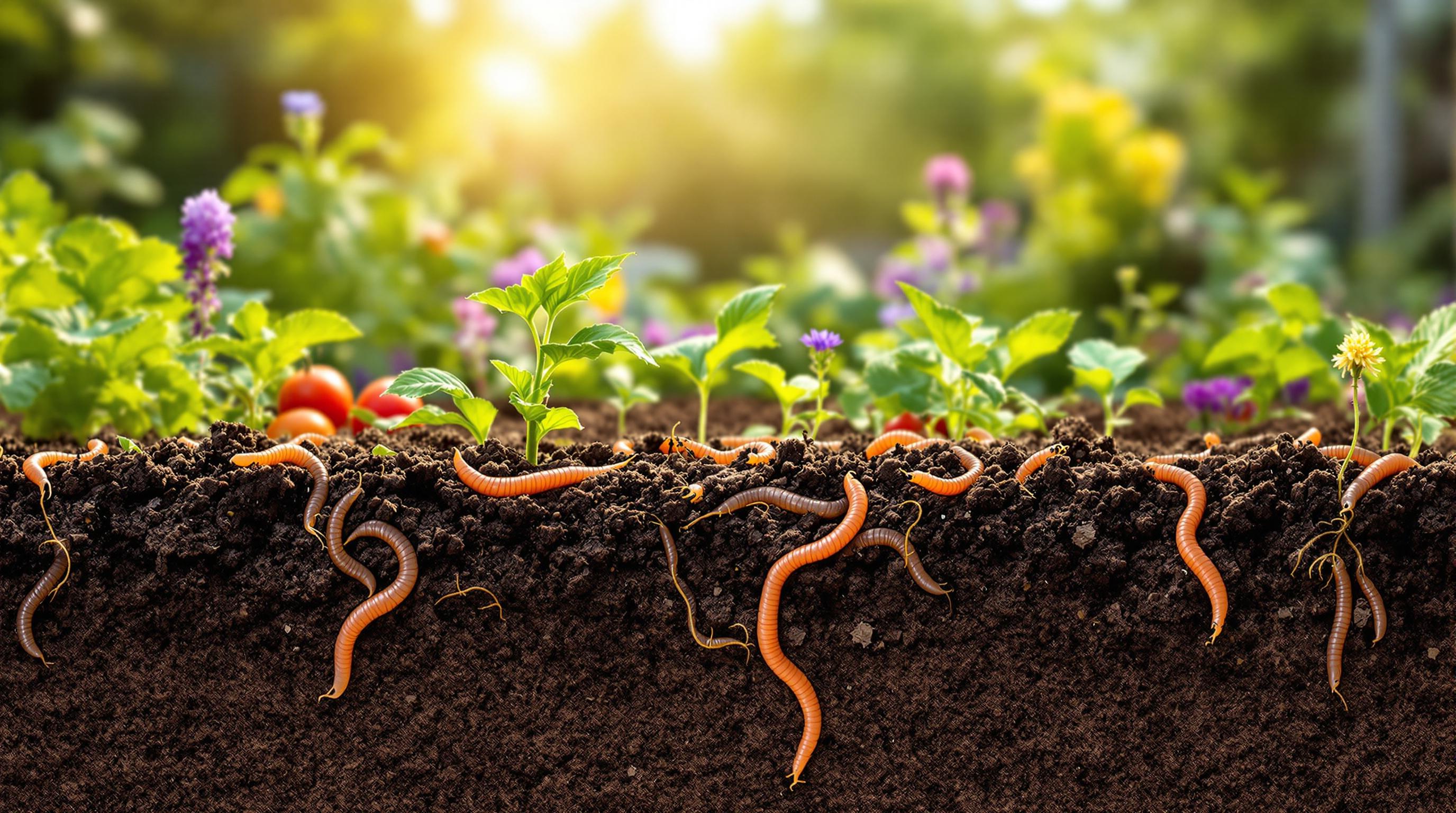A Comprehensive Guide to Creating a Living Soil Ecosystem for Your Garden
Living soil is the foundation of a thriving garden. It’s packed with microorganisms like bacteria, fungi, and earthworms that naturally break down organic matter, release nutrients, and improve soil structure. This reduces the need for synthetic fertilizers and pesticides while promoting plant health, water retention, and pest resistance.
Key Steps to Build Living Soil:
- Composting: Use hot or cold methods to recycle organic waste into nutrient-rich compost.
- Add Microorganisms: Blend coco coir, aeration materials, and compost or worm castings to boost microbial life.
- Natural Amendments: Use biochar, compost tea, or green manure to enrich soil.
Ongoing Care:
- Test soil pH (ideal: 6.5–7) and nutrient levels regularly.
- Add compost, mulch, and rotate crops to maintain fertility.
- Avoid soil compaction and chemical treatments to protect microbes.
Living Soil 101: Creating a Sustainable Ecosystem in Your Garden
Creating Living Soil
Building living soil involves a step-by-step approach that combines organic materials and soil-friendly organisms.
Composting Methods
Quality compost is the backbone of healthy soil. Did you know that more than 50% of household waste can be composted? This makes it a practical option for many gardeners. Here are two common composting methods:
- Hot Composting (Berkeley Method): This method uses a 1:2 ratio of green to brown materials. You'll need to turn the pile every other day and keep an eye on moisture levels. If done right, you can have compost ready in just 18 days.
- Cold Composting: A slower, hands-off approach that takes 6–12 months. While it won't kill weed seeds or pathogens, it still produces rich organic material for your soil.
Adding Microorganisms
Soil is home to billions of microbes, each playing a role in plant health. To enrich your soil's microbial life, start with a balanced mix. Fifth Season Gardening suggests this formula:
- 33% coco coir (a renewable alternative to peat)
- 33% aeration materials (like perlite or pumice)
- 33% quality compost or worm castings
This mix creates a strong foundation for long-term soil health and productive plant growth.
Natural Soil Additives
Natural soil amendments can improve structure and provide nutrients. Worm castings, for example, are packed with chitinase, an enzyme that helps manage pests.
"Worm casts are digested organic matter that has been run through the gut of the earthworm...Earthworms impart into their casts an incredible diversity of hygienic microorganisms that work to competitively exclude disease-causing organisms as well as a number of destructive pests such as root knot and root lesion nematodes." – Dr. Donald W. Trotter
Here’s a quick look at some popular natural amendments:
| Amendment Type | Benefits | Application |
|---|---|---|
| Biochar | Adds carbon and phosphorus | Mix into the top 6 inches of soil |
| Compost Tea | Delivers nutrients and microbes quickly | Use as a foliar spray or soil drench |
| Green Manure | Improves nitrogen levels and soil structure | Plant as a cover crop |
From composting to using natural additives, these steps will help you create a thriving soil ecosystem. Up next: soil testing and seasonal strategies to keep your soil healthy year-round.
Soil Care and Upkeep
Keeping your soil healthy is key to maintaining a thriving garden ecosystem. Knowing how to test and care for your soil throughout the year can make all the difference in your garden's success.
Soil Testing and Fixes
Testing your soil early helps you identify and address potential problems. Most garden plants grow best in soil with a pH between 6.5 and 7. To test, collect samples from a depth of 4–6 inches across different areas of your garden. Remove any debris, let the samples dry, and then test them.
| Testing Method | Cost Range | Accuracy Level | Best For |
|---|---|---|---|
| Lab Testing | $15-60/sample | Highest | Detailed nutrient analysis |
| Digital pH Meter | $20-100 | Good | Regular monitoring |
| Testing Strips | ~$12/100 strips | Moderate | Quick checks |
| Analog Probes | $7-30 | Basic | Simple pH readings |
Certain weeds can also provide clues about your soil's condition. For example, dandelions and wild strawberries often point to acidic soil, while chickweed and Queen Anne's lace suggest alkaline soil. Use these observations and test results to guide your soil care routine.
Year-Round Soil Care
Once you've established healthy soil, regular maintenance is key to keeping it fertile. For example, Rough Draft Farm in Lawrenceburg, Kentucky, adopted a no-till approach in 2018. By leaving roots in place and adding mulch, they significantly cut down on the time spent managing weeds.
"The key to soil health is in the biology, not in the chemistry" - Dr. Elaine Ingham, Soil Foodweb Inc.
Here are some essential practices to maintain soil health:
- Limit foot traffic to avoid compacting the soil.
- Add compost regularly: 1–2 inches for vegetable and flower beds, and up to 4 inches for trees and shrubs.
- Rotate plant families each year to prevent nutrient depletion.
- Plant cover crops in the off-season to reduce erosion and improve soil quality.
Avoid chemical pesticides to protect the beneficial microbes in your soil. By consistently adding compost, mulching, and practicing careful cultivation, you can support your soil's natural ecosystem year-round.
Tools and Supplies
Creating a thriving living soil ecosystem starts with having the right tools and materials. These items and projects align with the eco-friendly practices discussed earlier.
Recommended Products
To maintain a healthy living soil ecosystem, you'll need some essential tools. Green Genius, an Australian gardening and hydroponics store, offers eco-friendly options for everything from composting to soil testing. Here’s a quick overview of must-have items:
| Tool Category | Essential Items | Purpose |
|---|---|---|
| Composting Basics | Pitchfork, Compost Bin, Thermometer | Efficient compost setup |
| Soil Management | Hand Tiller, Hori Hori Knife, Shovel | Soil preparation and maintenance |
| Testing Equipment | Digital pH Meter, Moisture Meter | Soil health monitoring |
| Protection | Washable Garden Shoes, Gloves | Safety and comfort |
For improving soil health, focus on natural amendments. Worm castings, known for their slow-release nitrogen, enhance fertility when paired with mechanical tools. Adding mycorrhizal fungi can further improve root nutrient absorption.
If you’re looking to save money or customize solutions, DIY projects are a great alternative to store-bought products.
Home Projects
DIY gardening projects are not only budget-friendly but also highly customizable.
-
DIY Worm Farm
For less than $5, you can create a two-bucket worm farm that produces nutrient-rich castings. Use black-and-white newspaper for bedding and attract garden worms with wet cardboard to start your colony. -
Compost Tea Brewer
Build your own brewer using simple materials:- A 5-gallon food-grade bucket
- An air pump with a stone
- A paint can liner as a "tea bag"
- Binder clips to secure the liner
"The secret to bigger, healthier, pest/disease resistant produce is in the soil, and the secret to improving the health of your soil is this compost tea recipe. Grab my recipe and watch your garden flourish! Then head over and learn how to build your own compost tea brewer."
-
Raised Bed Construction
Build raised beds using untreated wood and a mix of your garden soil and compost. Teresa Chandler offers this advice:"Don't feel like you have to buy every gadget and tool to be successful. The most important thing is to get started! Work with what you have. Many ordinary garden tools are very useful for composting. You can always add more tools as you see a need."
Conclusion
Main Points
Healthy soil thrives when it holds moisture, provides nutrients, and supports a variety of microorganisms.
"Understanding your soil is the first step to creating an optimum soil ecosystem."
To achieve this, focus on these three key principles:
- Protect the Ecosystem: Limit soil disturbance by reducing tillage and cutting back on chemical use.
- Build Organic Matter: Add 1–2 inches of compost for flowers and vegetables, mixing it 6–8 inches deep.
- Maintain Soil Cover: Use mulch to shield soil life, conserve moisture, and prevent erosion.
By following these principles, you can create a thriving soil environment.
Next Steps
Ready to get started? Here are some actionable steps:
-
Soil Assessment
Send a soil sample to a lab to analyze texture, pH, nutrient levels, and organic matter content. This will give you a clear understanding of your soil's needs. -
Natural Amendments
Swap out chemical fertilizers for organic alternatives. Lisa Cullen from Montecito Landscape suggests letting fallen leaves break down naturally:"If you are raking up all your leaves, you are creating hardscape anyway."
-
Protection Plan
Use mulch to cover exposed soil and rotate crops to maintain nutrient balance and reduce disease risks. For trees and shrubs, mix 4 inches of compost into the soil to a depth of 12 inches.
Improving soil health is a step-by-step process, but the benefits grow over time.
Related posts
- Top 5 Eco-Friendly Fertilizers for Organic Gardens
- A Comprehensive Guide to Sustainable Gardening and Agriculture
- Exploring the Art and Science of KNF: Korean Natural Farming
- Revitalizing Growth: The Art and Science of Re-Amending Living Soils

